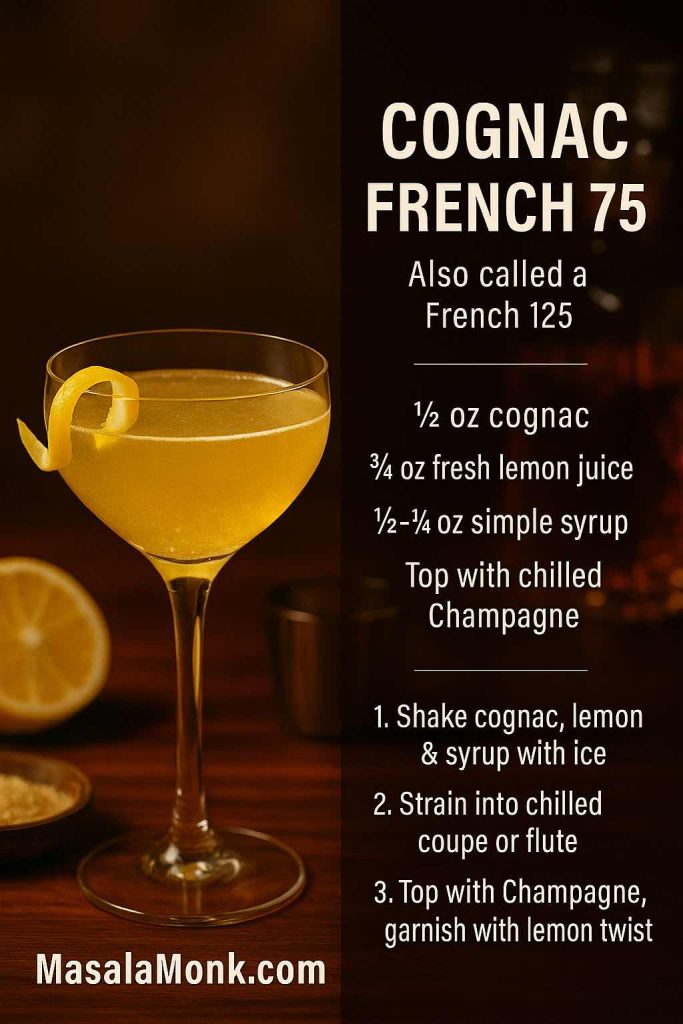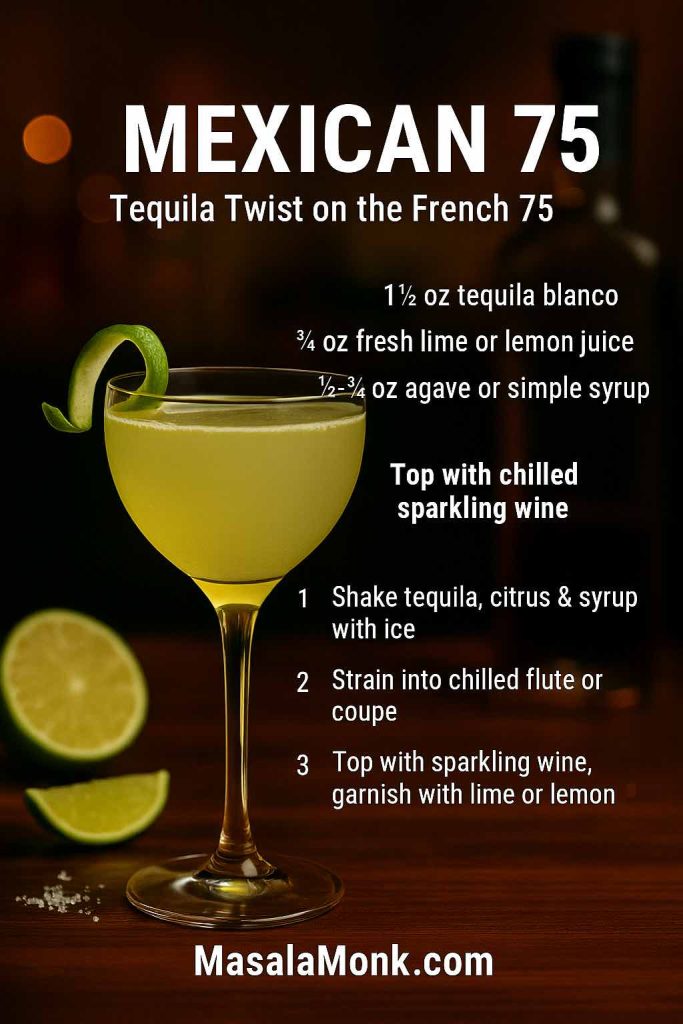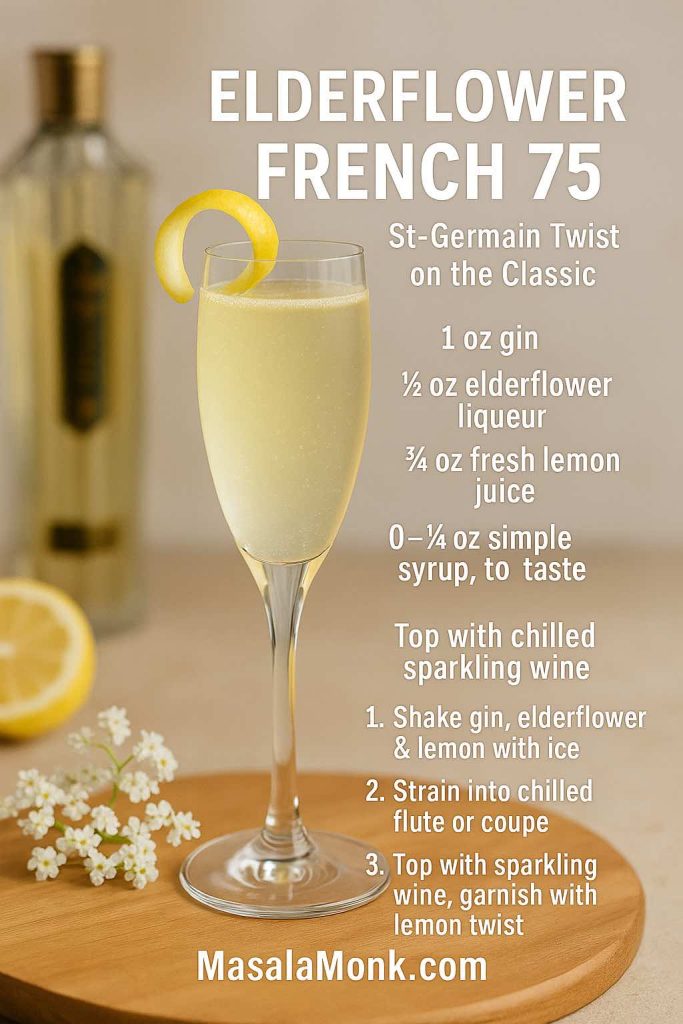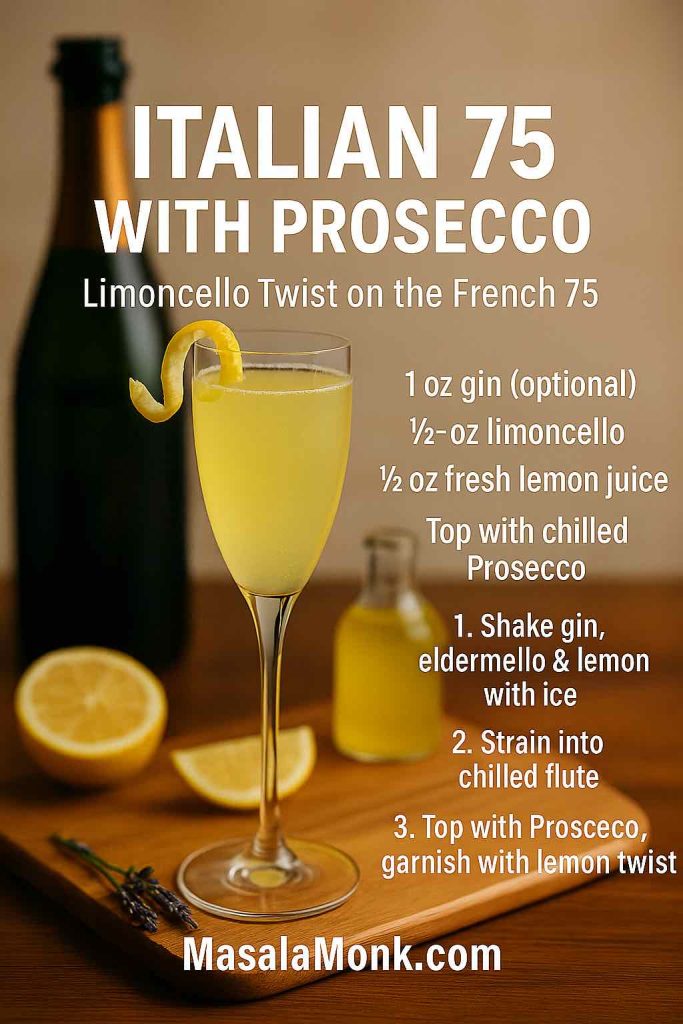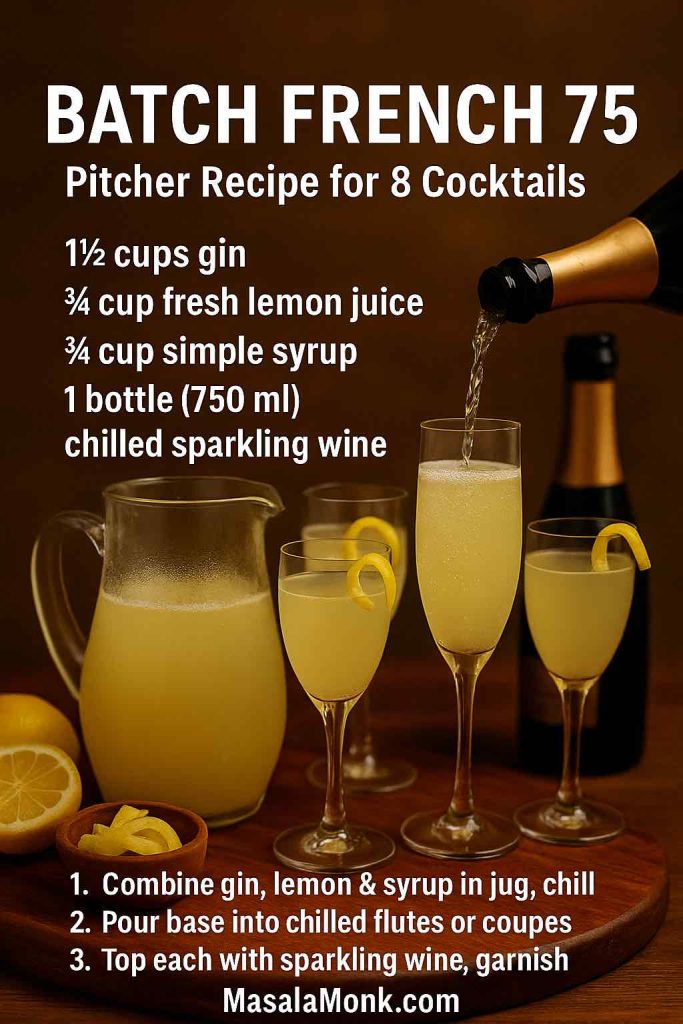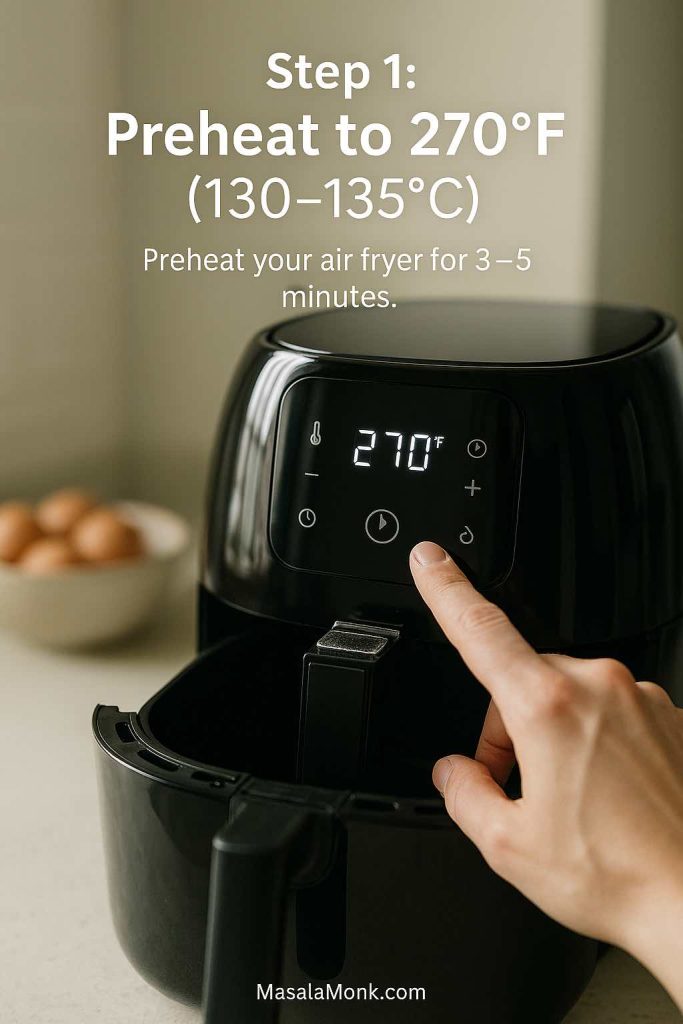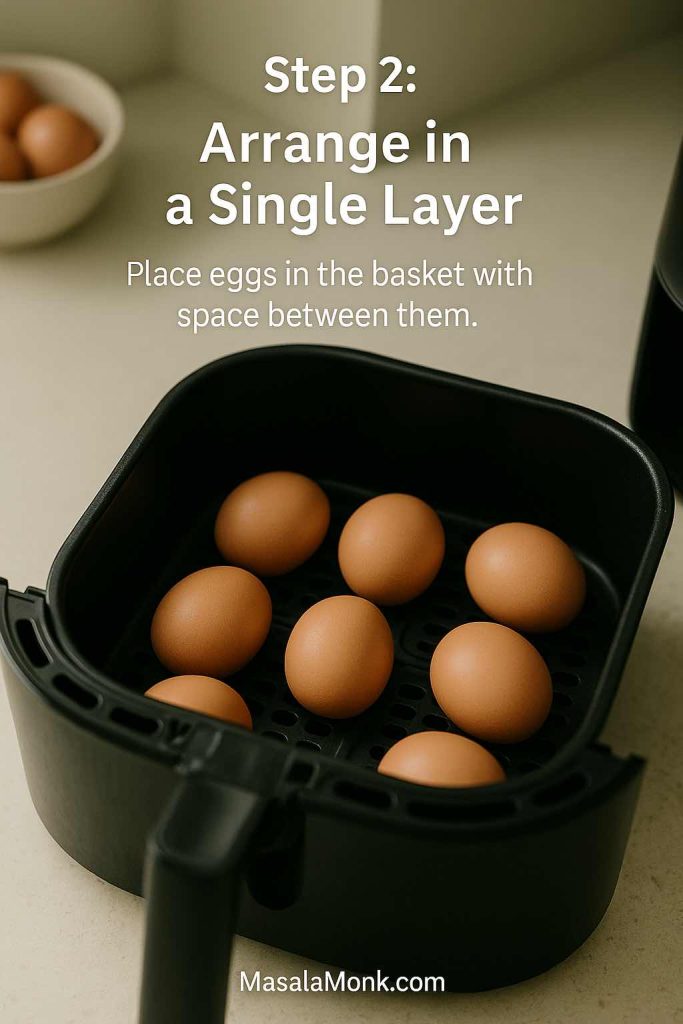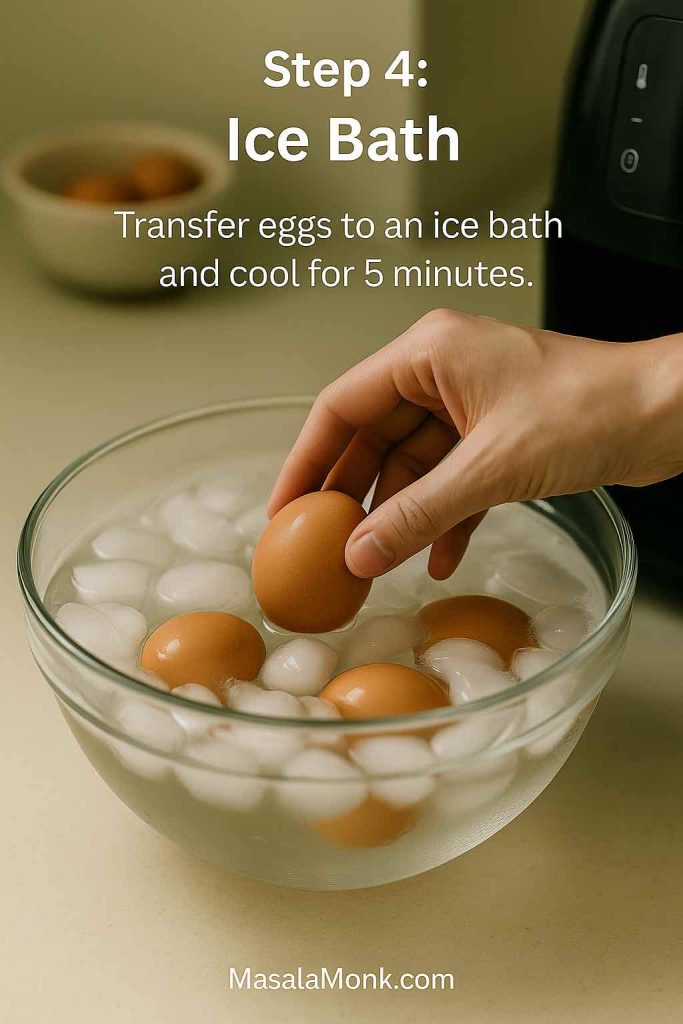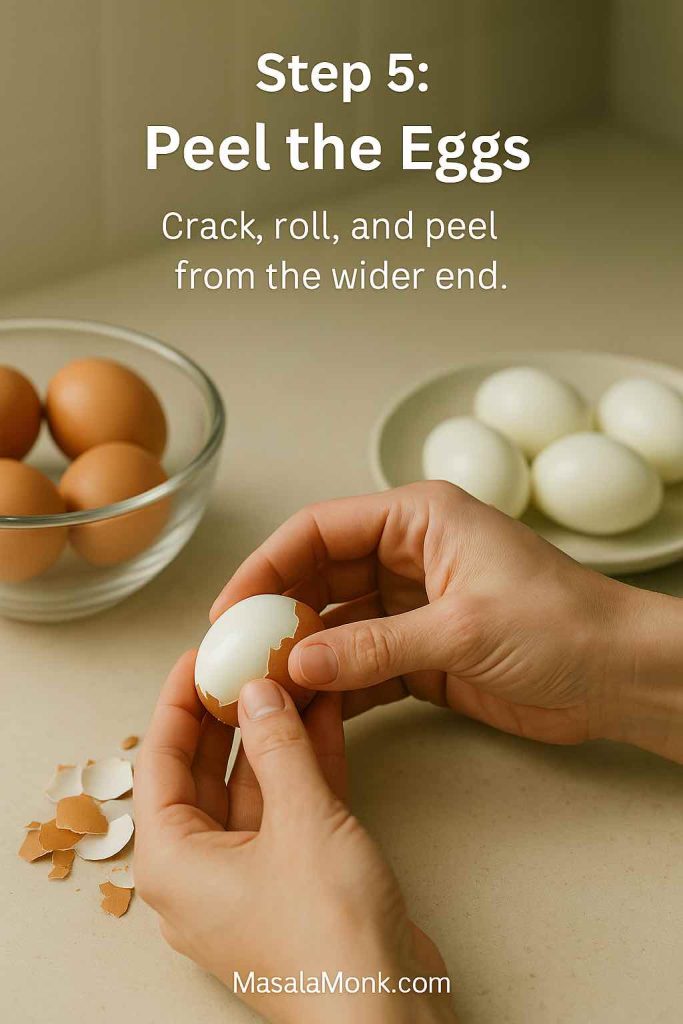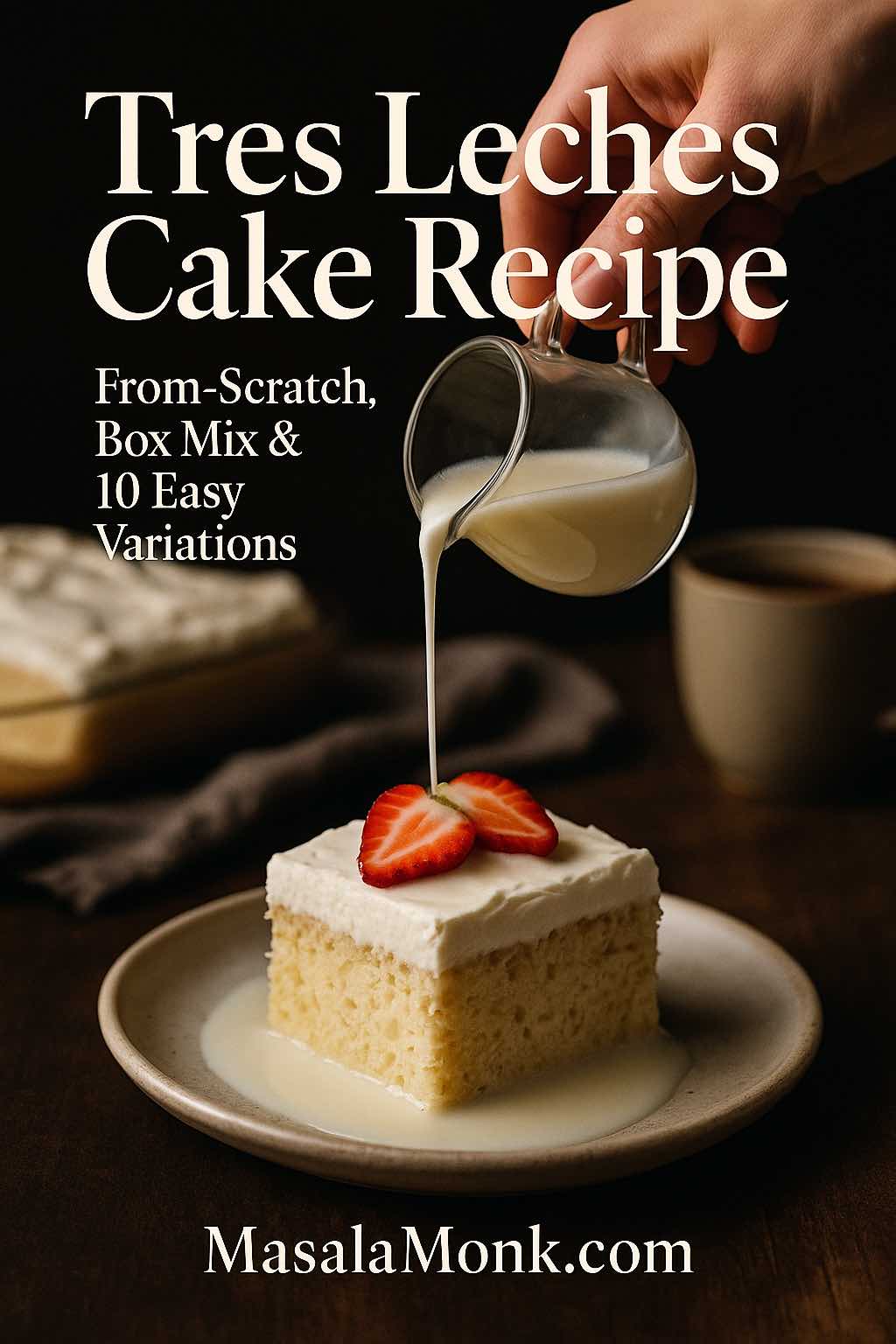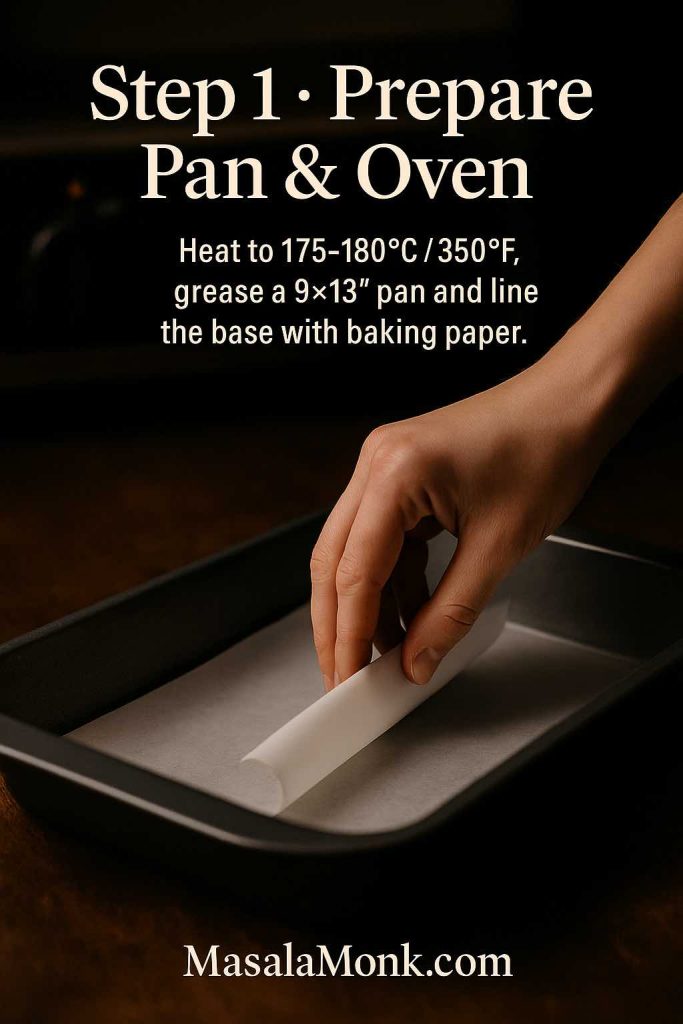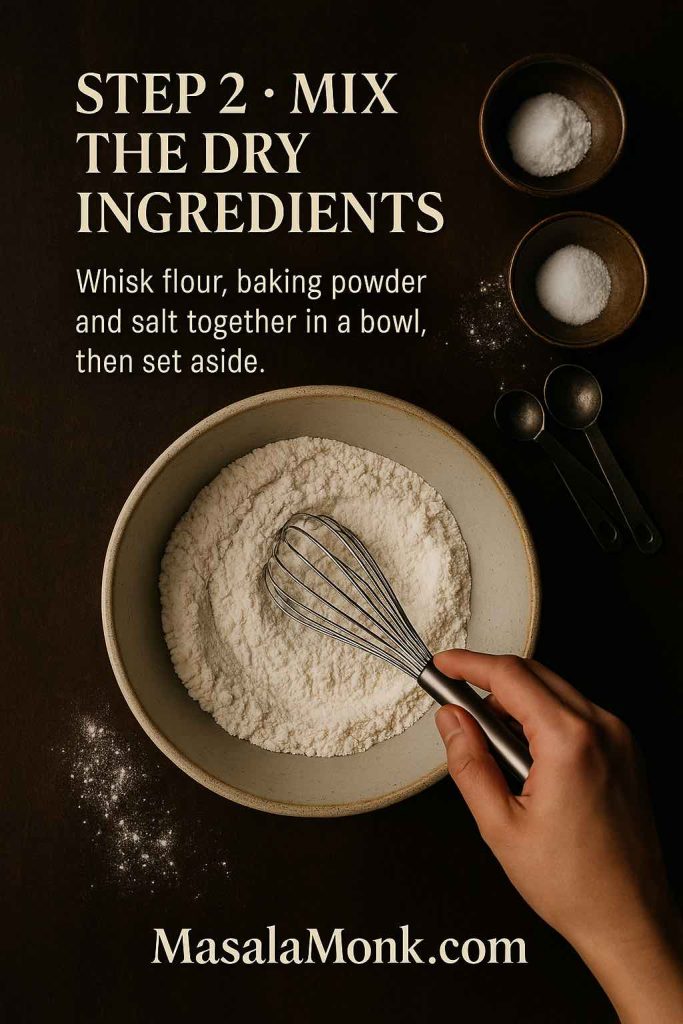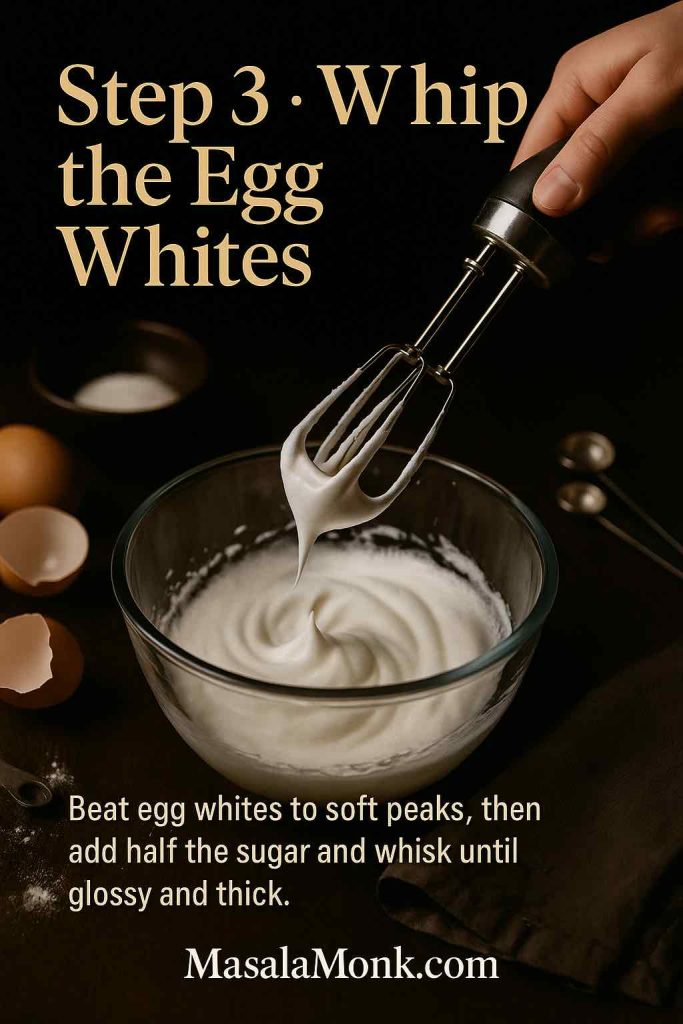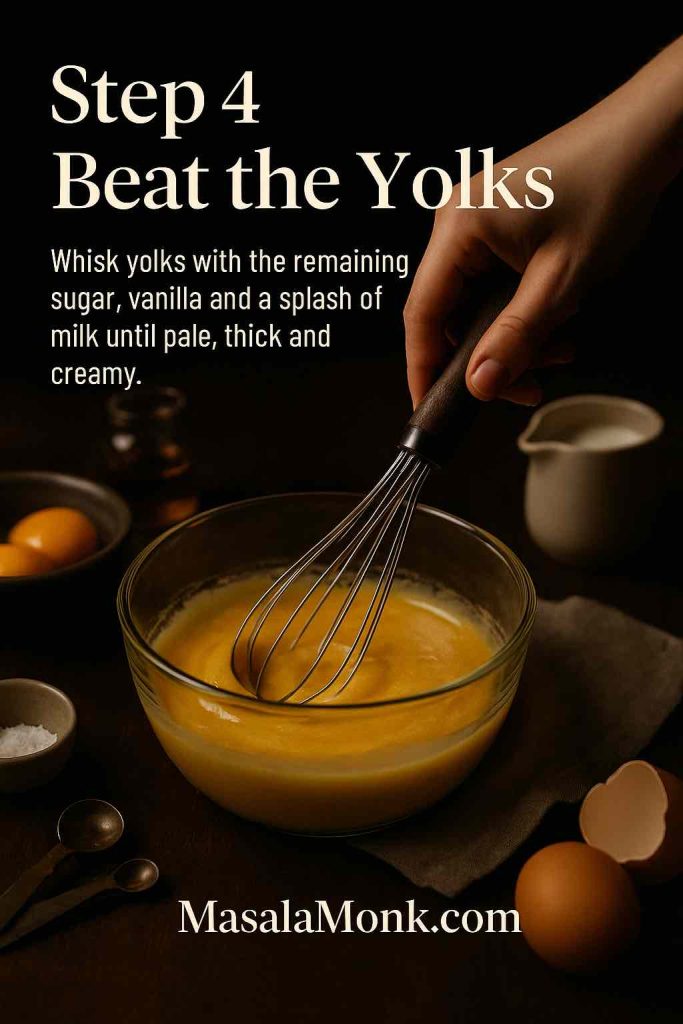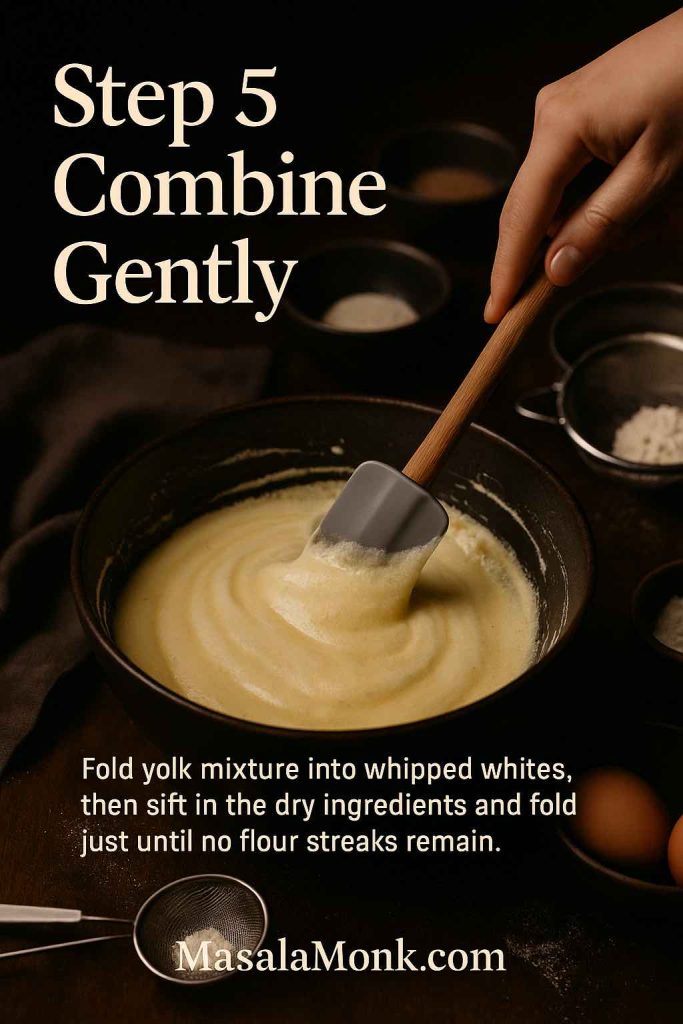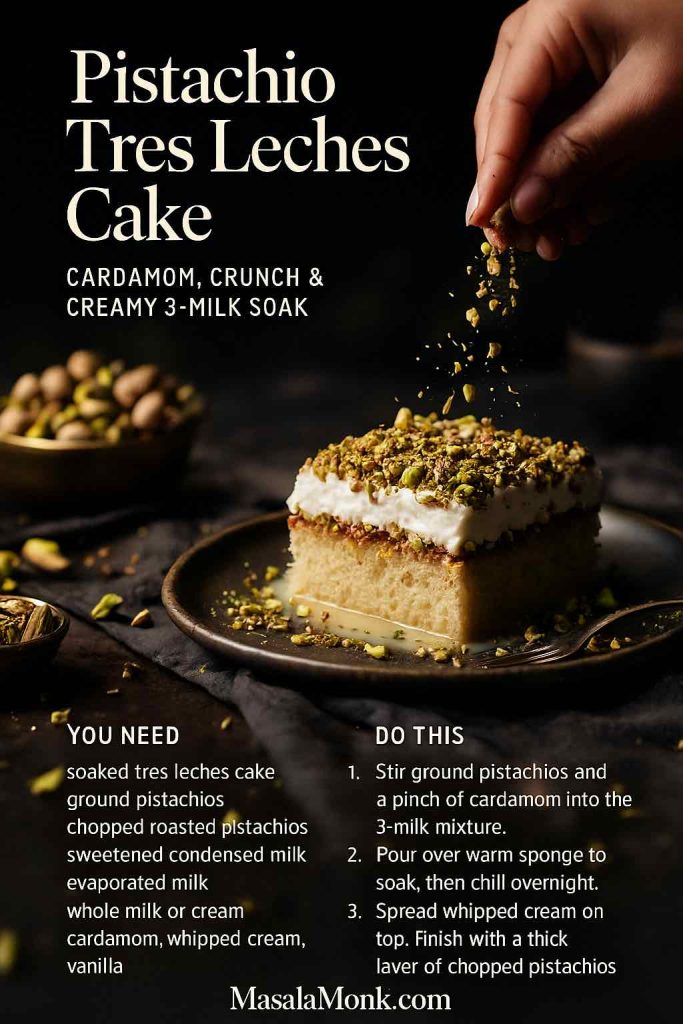
Green bean casserole is one of those dishes that people don’t just eat; they have feelings about it. It’s the side that sneaks into family stories, arguments about whose version is “right,” and a surprising number of Google searches every single year. Some search for the original green bean casserole recipe, others want it without cream of mushroom soup, some want a cheesy, bacon-loaded version, and more and more people are looking for dairy-free and vegan twists. Instead of treating all those green bean casserole cravings as separate problems, you can think of them as branches growing from the same very simple tree.
This post walks you through that tree: one classic base, then easy variations that match what people are actually looking for, plus smart ideas for what to serve with it—from cozy hot chocolate to bright cocktails and charcuterie boards.
The Classic Green Bean Casserole Recipe Everyone Expects
If there’s one green bean casserole recipe that defines the genre, it’s the one that came out of the Campbell’s test kitchen in 1955: green beans, condensed cream of mushroom soup, milk, soy sauce, pepper, and a generous crown of crispy fried onions. Campbell’s still hosts the canonical green bean casserole recipe, and it’s essentially unchanged after decades on holiday tables.
French’s later made its own mark by printing a very similar formula on the can of their fried onions; their green bean casserole leans a touch more soupy and generous with onions, but the soul is the same.
Ingredients for the Classic Green Bean Casserole Recipe
Serves: about 6
Pan: 1½-quart casserole or 8×8-inch dish
Oven: 350°F / 175°C
- 4 cups green beans
- 2 cans (about 14.5 oz each) cut green beans, drained, or
- 1 lb frozen green beans, thawed and drained, or
- 1 lb fresh green beans, trimmed and blanched 3–4 minutes
- 1 can (10.5 oz) condensed cream of mushroom soup
- ½ cup milk
- 1 teaspoon soy sauce
- ¼ teaspoon black pepper
- 1⅓ cups crispy fried onions, divided
That six-ingredient combo is exactly what Campbell’s calls a “no-fail” recipe in their printable version of Campbell’s Green Bean Casserole, right down to the 10 minutes of prep time and 60+ years of tradition.
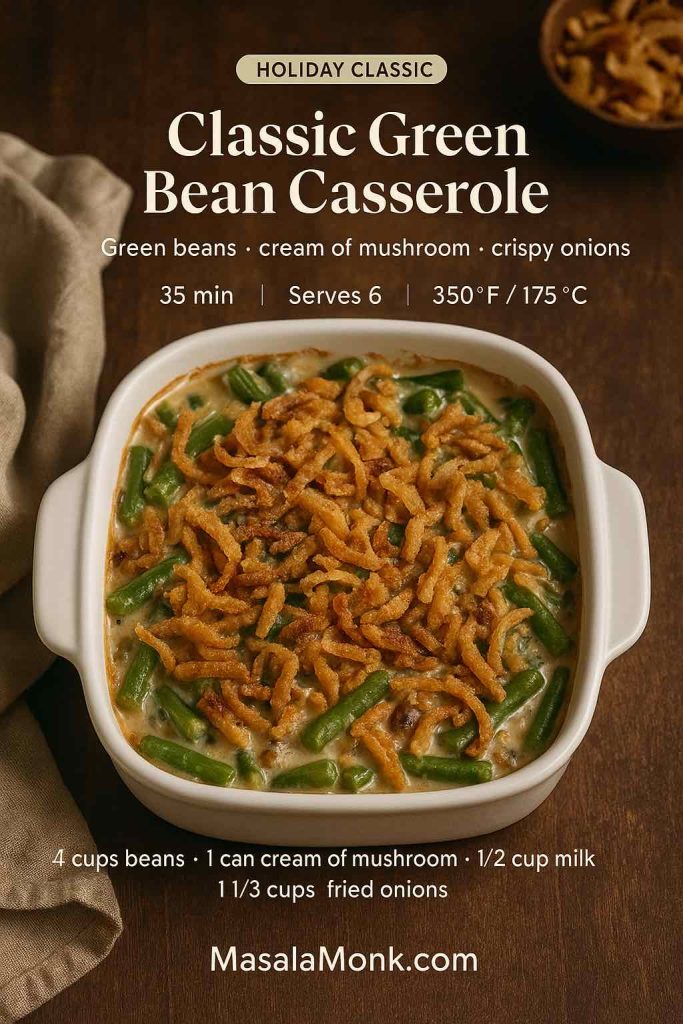
How to Make the Classic Green Bean Casserole
- Preheat the oven
Heat your oven to 350°F (175°C). Lightly grease your baking dish if it tends to stick. - Stir together the base
In a mixing bowl, combine the cream of mushroom soup, milk, soy sauce, and pepper until smooth. - Fold in the beans and onions
Add the green beans and ⅔ cup of the crispy fried onions. Stir just until everything is coated and evenly mixed. - Bake until bubbly
Spread the mixture into your casserole dish. Bake for about 25 minutes, until the edges are bubbling and the center looks hot. Both Campbell’s and Allrecipes’ version of Campbell’s green bean casserole follow this timing closely. - Add the onion topping
Give the casserole a quick stir, then scatter the remaining onions over the top in an even layer. - Finish in the oven
Return the dish to the oven for another 5–10 minutes, just until the onion topping is deeply golden and crisp.
That’s it: the original green bean casserole recipe, essentially unchanged since the 1950s, and still the most-searched version every November. Articles that pit Campbell’s vs French’s green bean casserole side by side usually end up confirming how small tweaks—like using fresh beans and a touch less milk—can subtly shift texture and flavor while staying firmly in “classic” territory.
Also Read: Air Fryer Hard-Boiled Eggs (No Water, Easy Peel Recipe)
Quick Green Bean Casserole Recipe Variations for Busy Days
Of course, life doesn’t always give you a leisurely hour to build side dishes. Sometimes you just need a green bean casserole recipe that you can throw together while the main course is already in the oven. The good news is that this dish is incredibly forgiving, so you can simplify it without losing its character.
Three-Ingredient Green Bean Casserole
When you’re in a rush or cooking for people who love things simple, you can pare the classic right down to its essentials:
- Green beans
- Condensed cream of mushroom soup
- Crispy fried onions
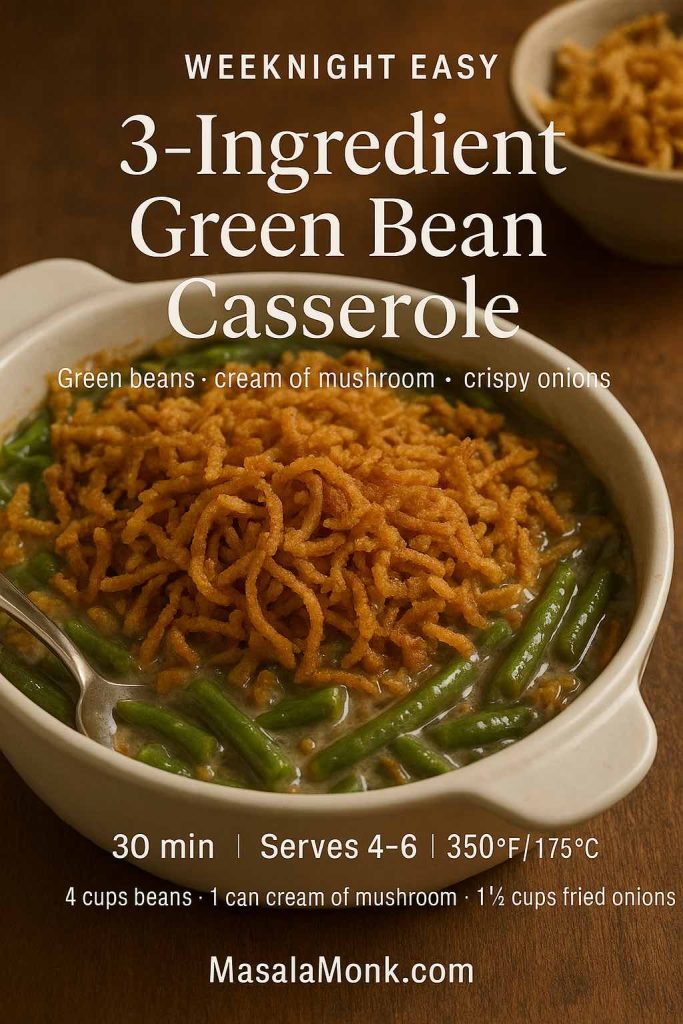
For a small casserole, combine:
- 4 cups green beans
- 1 can condensed cream of mushroom soup
- A generous handful of fried onions
Stir, spread into a baking dish, and bake at 350°F for 25–30 minutes. When it’s hot and starting to bubble, add more onions on top and bake another 5–10 minutes until everything looks bronzed and crunchy.
This version skips the milk and soy sauce, so it comes out thicker and a bit more intense—exactly the sort of easy bean casserole people search for when they type “3 ingredient green bean casserole.”
Green Bean Casserole for Two
Other days, you don’t need a huge pan at all. Maybe it’s you and one other person, or you’re tucking green bean casserole onto a small Sunday plate with roast chicken.
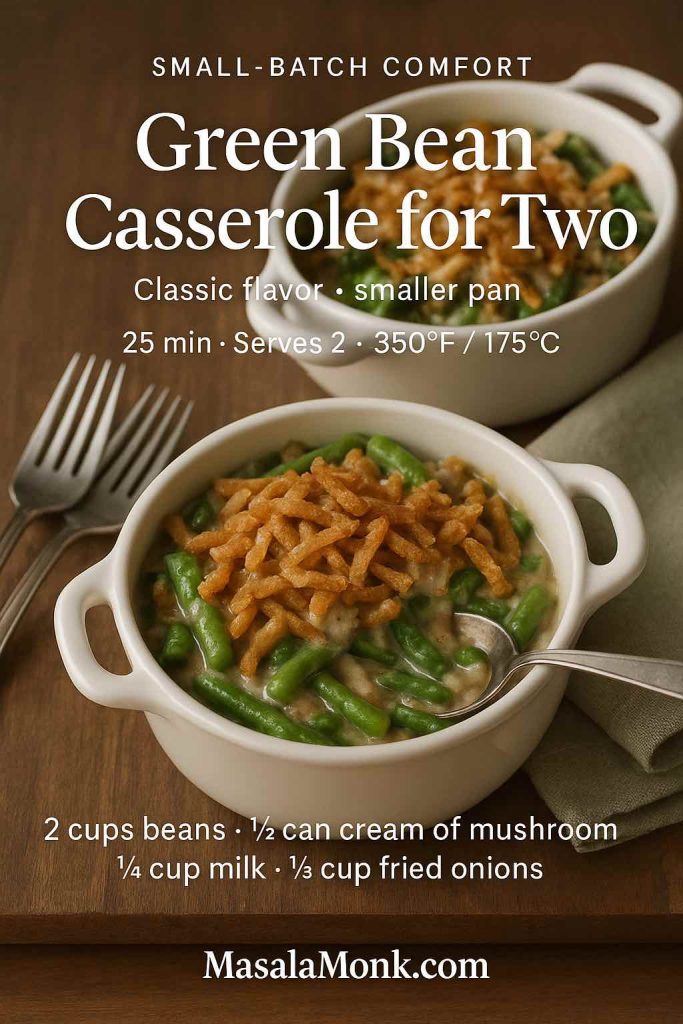
For a green bean casserole recipe for two, use:
- 2 cups green beans
- ½ can condensed cream of mushroom soup (about 1 cup)
- ¼ cup milk
- ½ teaspoon soy sauce
- Pinch of pepper
- About ⅔ cup crispy onions (⅓ cup mixed in, ⅓ cup on top)
Mix the sauce ingredients, fold in beans and a portion of the onions, and bake the mixture in a small baking dish or loaf pan at 350°F for 20–25 minutes. Top with the remaining onions and finish for 5–7 minutes.
It’s the same green bean casserole recipe, just scaled down so you get the comfort of a holiday side dish on a perfectly ordinary weeknight.
Make-Ahead and Leftover Green Bean Casserole
Because the texture is forgiving, this casserole also works beautifully for make-ahead cooking. You can assemble the base (without the final onion topping), cover it, and refrigerate it for up to a day. When you’re ready, bring it closer to room temperature, bake until hot and bubbly, and then finish with the fried onions.

Leftovers reheat well in the oven or air fryer. If you’d like to build a bigger menu around all this prep, you can pair your pan of greens with other make-ahead-friendly dishes, or even a board of meats, cheeses, and pickles inspired by MasalaMonk’s guide to charcuterie boards and the 3-3-3-3 rule.
Green Bean Casserole Ideas Without Cream of Mushroom Soup
A huge number of people look for one option: no canned soup. Sometimes it’s for flavor, sometimes for dietary reasons, sometimes because the store is out of cream of mushroom and nobody wants to go to a second supermarket.
There are two straightforward ways to build a green bean casserole recipe without relying on cream of mushroom.
Cream of Chicken Green Bean Casserole
The simplest shortcut is to skip mushroom entirely and swap in cream of chicken soup. This keeps the pantry convenience intact while changing the flavor profile.
To do it, follow the classic recipe exactly, but replace the cream of mushroom with condensed cream of chicken (or cream of celery). Many cooks make this swap directly, and brands themselves often suggest cream of chicken as a flavor variation in their holiday green bean casserole notes.
You still get that creamy, clingy sauce, just with a gentle chicken note instead of the earthiness of mushrooms.
From-Scratch Sauce: Green Bean Casserole Ideas With No Cream Soup
If you’d rather skip condensed soup entirely, a simple homemade white sauce gives you all the texture you need. Recipes like Rachel Cooks’ homemade green bean casserole without canned soup show exactly how this works: sauté some veg in butter, sprinkle flour, whisk in milk, and season.
A basic version looks like this:
- 3 Tbsp butter
- 3 Tbsp flour
- 1½ cups milk (or 1 cup milk + ½ cup chicken or vegetable broth)
- ½–¾ tsp salt
- ¼ tsp pepper
- 1–2 tsp soy sauce or Worcestershire
- Optional: a pinch of garlic powder, onion powder, or paprika
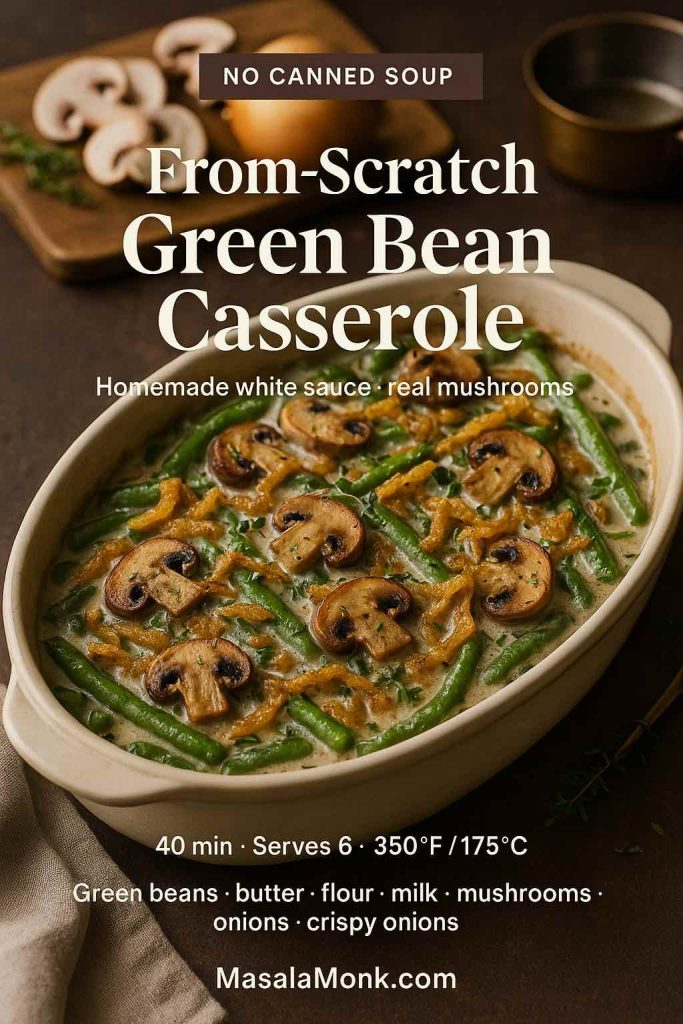
Melt the butter, stir in flour, and cook for a minute or two. Slowly whisk in the liquid and seasonings and keep stirring until you have a thick, glossy sauce that coats the back of a spoon. Use that in place of the canned soup + milk in the original green bean casserole recipe.
Several from-scratch casseroles, such as Feel Good Foodie’s green bean casserole, go a step further and fold sautéed mushrooms and onions into the sauce, creating something that tastes far more “restaurant” than “back of the can.”
Mushroom-Free Green Bean Casserole
If you simply don’t like mushrooms at all—or someone at the table can’t eat them—you can keep the homemade sauce but ditch the mushrooms entirely:
- Make the white sauce above.
- Season it well with garlic, onion, pepper, and perhaps a little nutmeg.
- Toss with green beans and bake exactly as you would the classic.
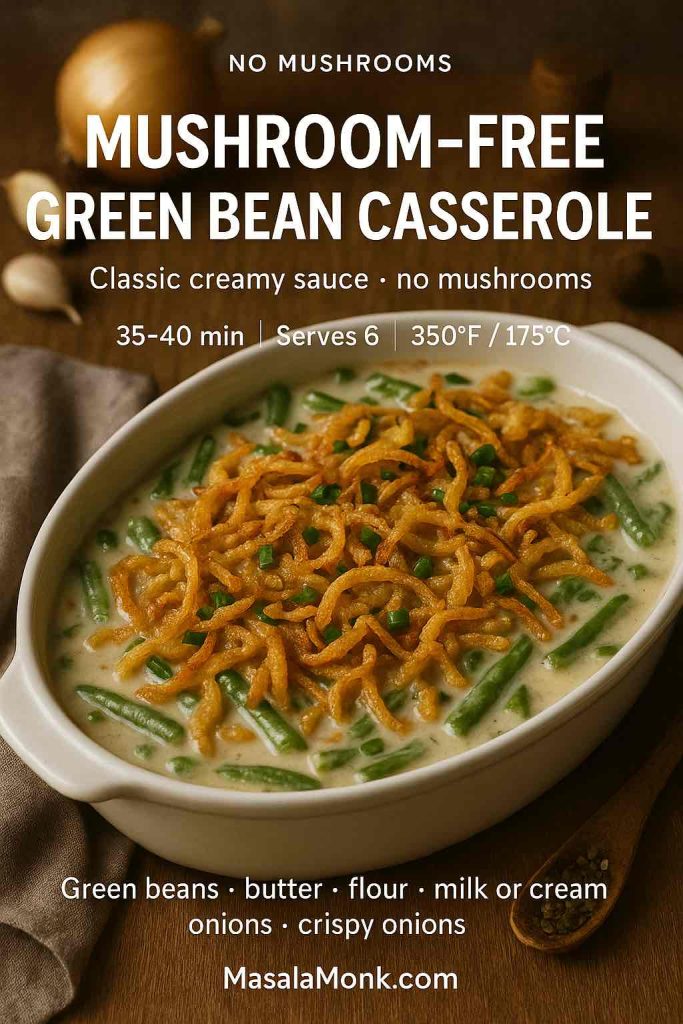
It’s still a traditional green bean casserole recipe in spirit, just with a smoother, mushroom-free personality.
Also Read: Tres Leches – Mexican 3 Milk Cake Recipe
Cheesy Green Bean Casserole Ideas
Once you’ve nailed the basic formula—beans + creamy sauce + crispy topping—you can build richer versions in layers. In practice, many home cooks have already moved in this direction; Allrecipes notes that its most-popular Best Green Bean Casserole adds cheddar cheese to the classic four ingredients, and people love it for that extra depth.
Cheddar Green Bean Casserole
Start with the classic base and stir 1 cup shredded cheddar into the soup mixture before adding the green beans. Medium or sharp cheddar both work well; the sharper the cheese, the more it stands up to the rich sauce.
As the casserole bakes, the cheese melts and thickens the sauce, turning your green bean casserole recipe into something closer to a hybrid of mac and cheese and the classic side dish.
Cream Cheese Green Bean Casserole
If you want velvety richness, cream cheese is your friend:
- Soften 4 oz cream cheese.
- Beat it into the soup + milk mixture until smooth.
- Thin with a splash of milk if it looks too thick to fold through the beans.
Then continue as usual—beans, onions, bake, top, bake again. The cream cheese adds body and a mild tang that plays especially well with fresh green beans, where you can still taste the snap beneath the sauce.
Sour Cream Green Bean Casserole
Some cooks go even further and use sour cream instead of canned soup at all, crafting a green bean casserole recipe that is tangy from top to bottom. That style has shown up in various popular home-cooking write-ups, where testers found sour-cream-based versions sometimes more appealing than the packet-exact original.
If you’re not quite ready for that big a leap, you can simply replace ¼ cup of the milk in the classic formula with ¼ cup sour cream. It still tastes like the green bean casserole you expect, just with a fresher, slightly brighter finish.
Bacon and Cheddar Green Bean Casserole
For a real crowd-pleaser, especially if the casserole is headlining a smaller meal, bacon and cheddar are hard to beat:
- 4–6 slices bacon, cooked until crisp and crumbled
- ¾–1 cup shredded cheddar
Fold the cheese and most of the bacon into your casserole base before baking, then save a little bacon to scatter under the fried onions at the end.

This approach mirrors the way modern recipes and celeb versions—like Chrissy Teigen’s ham- and cheese-enriched casserole that turned the dish into a main course—push green bean casserole into heartier territory while still keeping its creamy, onion-topped soul intact.
Also Read: High Protein Overnight Oats | 5 Recipes (Low Calorie, Vegan, Bulking & More)
Turning a Green Bean Casserole Idea into a Full Meal
Sometimes, green bean casserole doesn’t want to be a side. It wants to be dinner. That’s where the meat-heavy “hotdish” style comes in.
Green Bean and Hamburger Casserole
To build a green bean casserole recipe with hamburger or ground beef:
- Brown ½–1 lb ground beef with chopped onion, salt, and pepper.
- Drain off the excess fat.
- Stir the cooked beef into the classic casserole mixture.
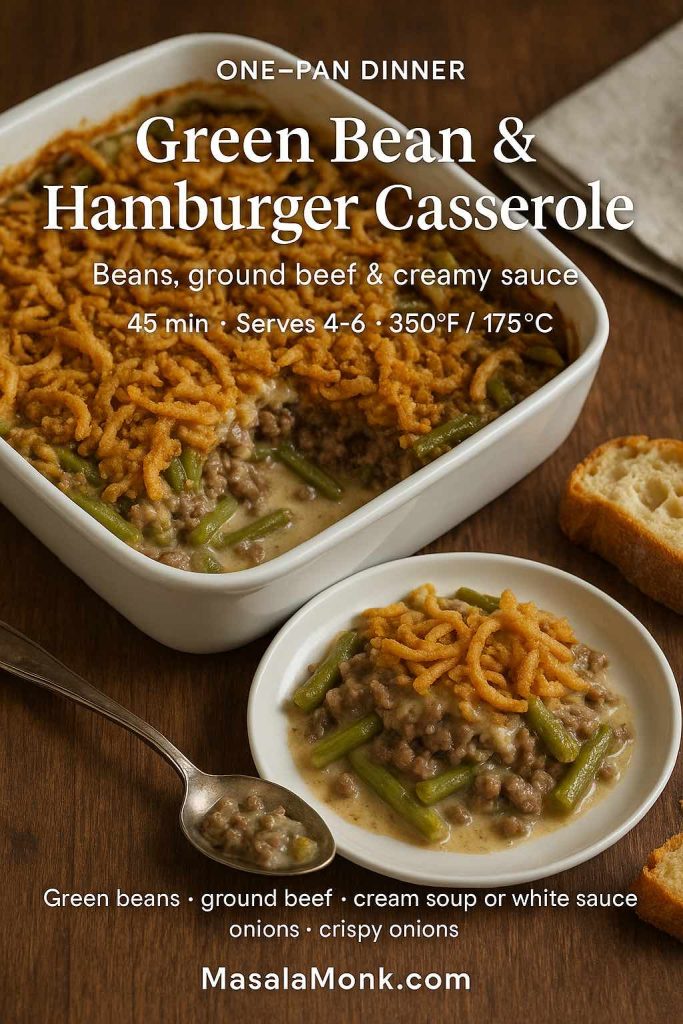
From there, bake exactly as you would the original. The result feels like a complete meal in a pan—beans, beef, sauce, and crunchy topping all in one place.
Green Bean Tuna Casserole
If you’d prefer something more pantry-friendly, tuna works just as well:
- Drain 1 can (5–6 oz) tuna, flake it, and fold it into the sauce and beans before baking.
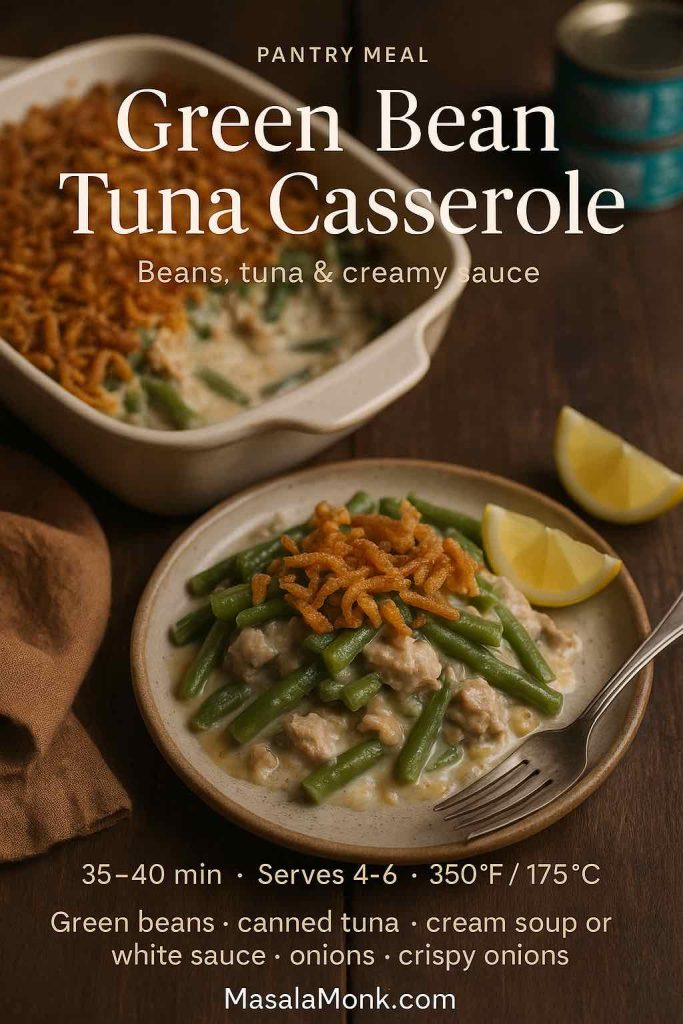
You end up with a cross between tuna noodle casserole and the classic green bean casserole recipe, only without the pasta. It’s quick, uses things you probably have on hand, and makes a comforting, slightly nostalgic supper.
Ham-Loaded or “Post-Holiday” Green Bean Casserole
After a big holiday meal, leftovers almost invite you to improvise. Chopped ham or smoked sausage stirred into your green bean casserole base can transform it into a clever second-day dish.
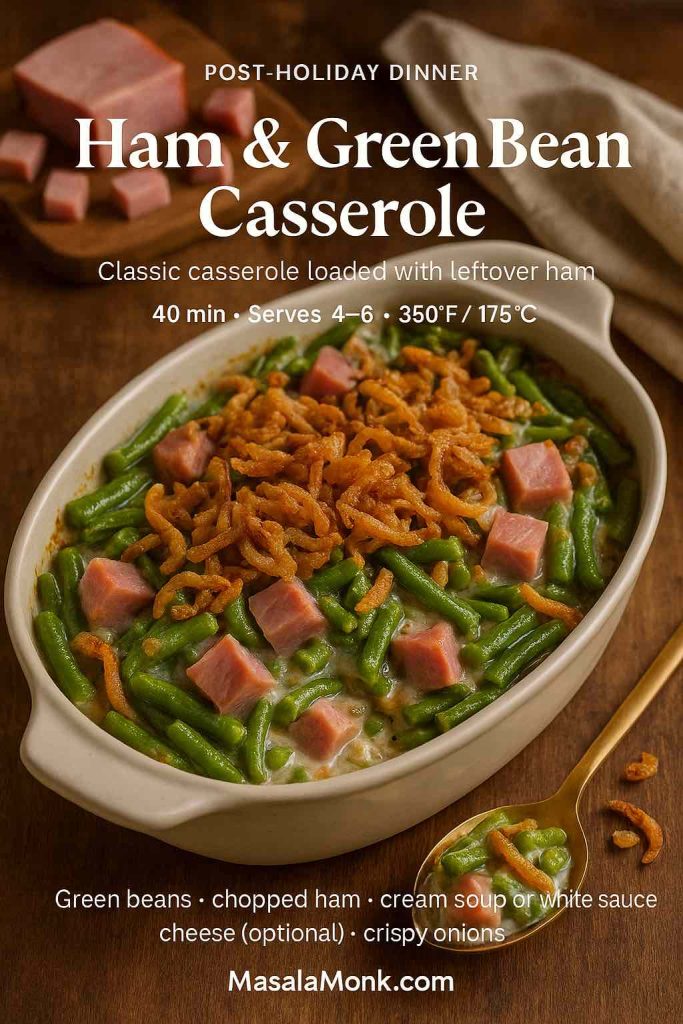
Magazine tests of ham-and-cheese casseroles based on the classic show that this kind of tweak can make the dish genuinely main-dish-worthy without losing the cream-and-onion familiarity people crave.
Also Read: 10 High Calorie Protein Shakes & Smoothie Recipes for Healthy Weight Gain
Fresh, Frozen, or Canned? Choosing Beans for Your Green Bean Casserole
One of the smallest but most important choices you make is what kind of green beans to use. The original Campbell’s test kitchen version allowed for canned, frozen, or fresh beans. Over time, food writers started experimenting with all three in taste tests.
Canned Green Beans
Canned beans are the most “retro” option:
- Very soft texture
- Ultra-convenient—no blanching or thawing
- Slightly muted color
If you grew up eating green bean casserole from a relative who swore by canned beans and cream of mushroom soup, this texture is probably what you imagine. The Allrecipes Green Bean Casserole I is a perfect example, keeping the old-school canned-bean feel.
Frozen Green Beans
Frozen beans offer a nice middle ground:
- Firmer than canned
- No trimming needed
- Easy to measure
You can add them thawed and thoroughly drained straight into the sauce. They keep a pleasant bite after baking, especially in slightly less soupy versions of the casserole.
Fresh Green Beans
Fresh beans give the most lively result:
- Bright color
- Crisp-tender texture
- Slightly more work up front
Blanching is important here. Drop trimmed beans into salted boiling water for 3–4 minutes, then drain and cool them quickly in cold water. Pat them dry so they don’t water down your sauce. Recipes that deliberately lean “from scratch,” like Feel Good Foodie’s fresh-leaning casserole, almost always reach for fresh or frozen beans to get that extra texture and color.
Interestingly, when Simply Recipes compared the Campbell’s vs French’s green bean casserole recipe, the version that encouraged fresh or frozen beans rather than strictly canned came out ahead for flavor and texture.
Also Read: How to Cook Perfect Rice Every Time (Recipe)
Dairy-Free and Vegan Green Bean Casserole Ideas
As more eaters avoid dairy—whether for health, ethics, or preference—vegan and dairy-free green bean casserole has gone from niche curiosity to holiday necessity. The good news is that the structure of the dish makes it relatively easy to adapt.
Lactose-Free Green Bean Casserole
If you’re okay with dairy proteins but avoiding lactose:
- Swap regular milk for lactose-free milk in the classic recipe.
- Use lactose-free sour cream or cream cheese in cheesy versions.
- Stick to aged cheeses like cheddar, which naturally contain less lactose.
The method and baking time stay exactly the same, so your green bean casserole recipe remains familiar while being kinder to sensitive stomachs.
Fully Dairy-Free Green Bean Casserole Idea
For fully dairy-free versions, you have a few different paths, all of which show up in popular vegan recipes.
One approach, used in recipes like The Best Vegan Green Bean Casserole, is to build a sauce from sautéed vegetables and plant milk.
Another option, seen in Healthy Green Bean Casserole from Eating Bird Food, is to base the sauce on cashew cream—soaked cashews blended with water or broth and seasonings—to create luxuriously thick, dairy-free “cream of mushroom.”
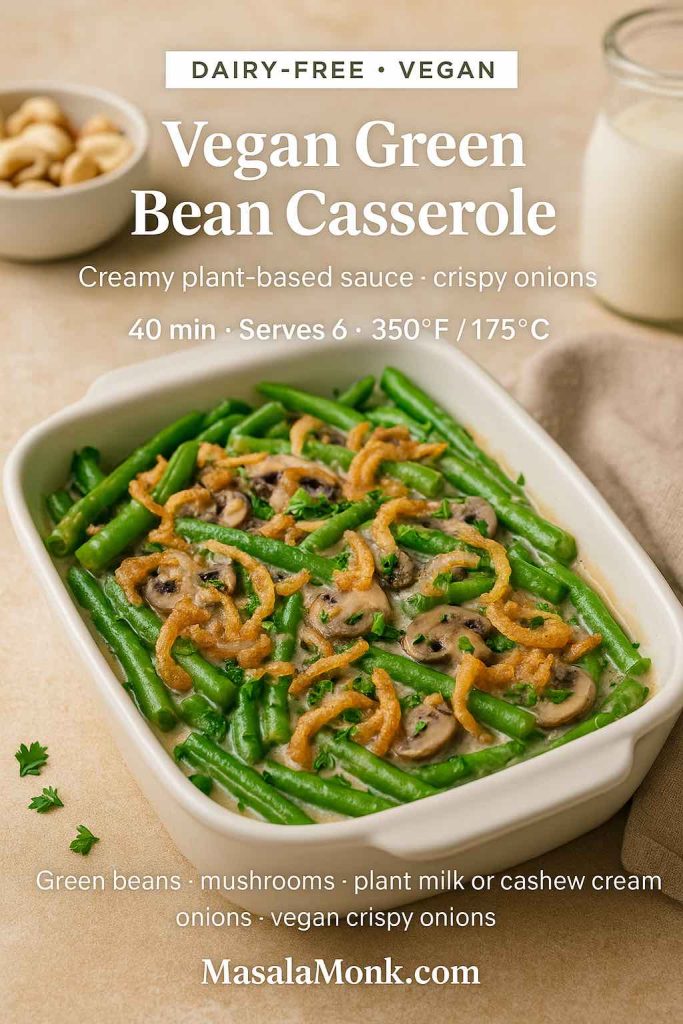
Here’s a simple template you can fold into your own green bean casserole recipe:
- Sauté the aromatics
Cook sliced mushrooms and onions in olive oil until golden and fragrant. Add garlic if you like. - Add flour or a gluten-free thickener
Sprinkle in flour (or a gluten-free substitute) and cook for a minute. - Pour in plant milk and/or broth
Use unsweetened soy, oat, or almond milk plus vegetable broth. Season with salt, pepper, soy sauce, and perhaps a little nutritional yeast for umami. - OR use cashew cream
Blend soaked cashews with water or broth, salt, onion powder, and a splash of lemon juice, then add that to the pan and cook until thick. - Combine, top, and bake
Toss the sauce with blanched green beans, transfer to a dish, and top with store-bought or homemade crispy onions that happen to be vegan.
In all these versions, the dish still looks and behaves like the classic; it’s just built on a different, plant-based foundation.
Also Read: Vegan French Toast: 6 Easy Recipes (Pan, Air Fryer, GF & High-Protein)
Is a Green Bean Casserole Low-Carb or Keto-Friendly?
This is another question that shows up frequently: is green bean casserole okay on a low-carb or keto-style diet? The answer is nuanced.
On one hand, the traditional green bean casserole recipe uses condensed soup, flour-thickened sauces, and fried onions—all of which add carbs. On the other hand, green beans themselves are surprisingly friendly to lower-carb eating patterns.
Healthline’s overview of beans on a keto diet points out that most beans are too carb-dense for a staple role, but green beans and black soybeans are notable exceptions, coming in at just 2 grams of net carbs per half-cup serving.
MedicineNet’s guide to green beans on a low-carb, keto-friendly diet reaches a similar conclusion: green beans are one of the easier vegetables to fit into a low-carb plan, especially when portion sizes are reasonable.
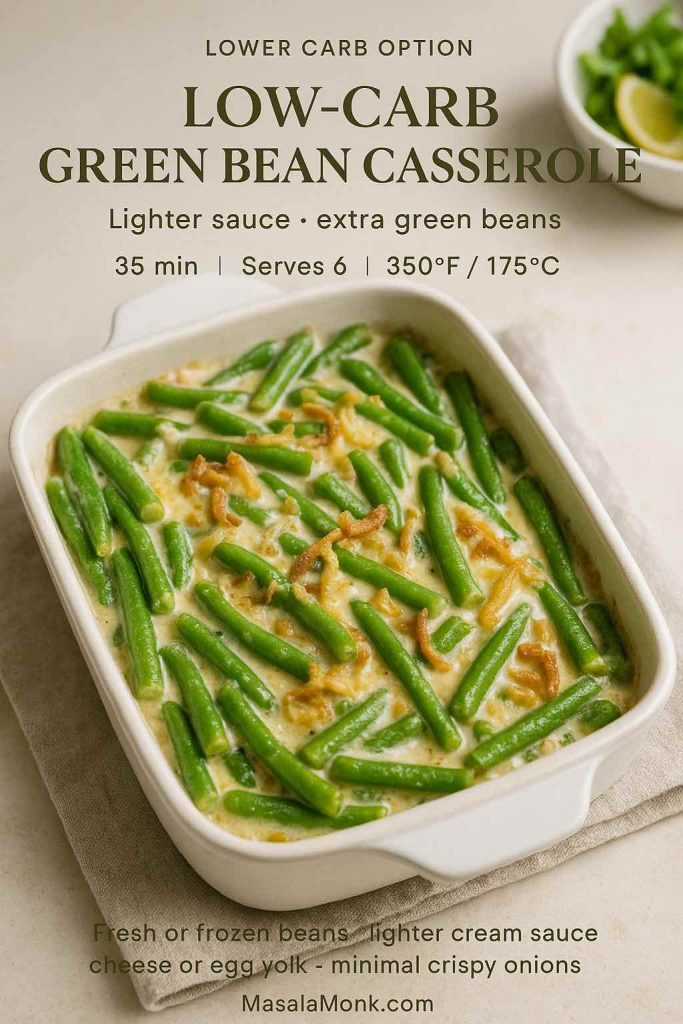
If you’re cooking for low-carb eaters, you can tilt your green bean casserole recipe in their direction by:
- Using fresh or frozen beans instead of canned varieties with added sugars
- Making a from-scratch sauce with less flour, or thickened with egg yolk or blended cauliflower
- Going lighter on fried onions and cheese, or using smaller portion sizes
For readers who want more detail on how beans fit into keto in general, our post Keto Beans: 5 Varieties That Won’t Ruin Your Diet, highlights green beans as one of the more forgiving choices.
What to Serve with Your Green Bean Casserole
Once the casserole is sorted, the next question is: what goes around it? Here’s where you can have fun with textures, flavors, and drinks.
Cozy Non-Alcoholic Pairings
On a chilly evening, especially around winter holidays, a plate of roast meat, mash, and green bean casserole alongside a steamy mug of something rich feels like a complete scene.
If you’d like a drink to match the comfort level of your green bean casserole recipe, consider a proper hot chocolate instead of just cocoa powder stirred into hot milk. MasalaMonk’s Homemade Hot Chocolate with Cocoa Powder breaks down how to get a deep, glossy chocolate drink using pantry cocoa, with tips for making it dairy-free or extra creamy.
You can also lean into simple breads and rolls, or even add a small charcuterie board—cured meats, cheeses, pickles, and spreads arranged according to the charcuterie board 3-3-3-3 rule—as a starter while the casserole finishes heating.
Classic Cocktail Matches
If your table includes cocktails, creamy food loves drinks that are either bright and citrusy or gently bitter.
A whiskey sour is right at home next to a rich green bean casserole recipe. The lemon, sugar, and whiskey combination cuts through heavy sauces and fried toppings. MasalaMonk’s whiskey sour cocktail recipe walks through classic ratios and also covers egg-white and no-egg versions if you want that frothy, bar-style top.
Gin is another natural partner. A slightly herbal, citrus-forward sour or highball from the collection of creative gin cocktail recipes keeps the palate refreshed between bites of creamy casserole and buttery potatoes.
And when dessert rolls around, the casserole will happily give way to Baileys-based drinks from What Mixes Well with Baileys?, whether you go for a Baileys flat white martini or something closer to an Irish coffee.
Bringing It All Together
In the end, nearly every version of green bean casserole you’ve ever seen—Campbell’s, French’s, Grandma’s, a viral blogger’s, or your own late-night experiment—follows the same simple structure:
- A green bean base, fresh, frozen, or canned
- A creamy, savory sauce, whether from a can or made in a pan
- A crunchy, oniony topping
Once you understand that, a single green bean casserole recipe can turn into dozens of variations with tiny moves:
- Keep it classic with the original Campbell’s green bean casserole proportions for guaranteed nostalgia.
- Swap soup flavors or make your own sauce to skip canned cream of mushroom.
- Fold in cheddar, cream cheese, or sour cream for indulgent, restaurant-style richness.
- Stir in bacon, hamburger, ham, or tuna when you want the casserole to be a full meal.
- Adapt it with plant milk and cashew cream when you need a dairy-free or vegan show-stopper.
- Nudge it towards low-carb with fresh beans, a lighter sauce, and a little restraint on the fried onions.
Serve it next to a roast and a whiskey sour, or alongside a simple salad and a mug of homemade hot chocolate. Either way, the same humble pan of beans, sauce, and onions quietly anchors the table—just as it has for nearly seventy years, and just as it will for countless dinners to come.
Also Read: Peanut Butter Cookies (Classic Recipe & 3 Variations)
FAQs
1. What is the classic green bean casserole recipe?
The classic green bean casserole recipe is the one built on green beans, condensed cream of mushroom soup, milk, soy sauce, black pepper, and a topping of crispy fried onions. Traditionally, you mix the soup, milk, and seasonings, fold in the beans and some onions, then bake until bubbly before adding the rest of the onions on top and returning the dish to the oven. This original style stays very simple, which is exactly why it shows up year after year on holiday tables.
2. Can I make a green bean casserole recipe without cream of mushroom soup?
Yes, you absolutely can make a green bean casserole recipe without cream of mushroom soup. One straightforward option is to swap in condensed cream of chicken or cream of celery, which keeps the method identical while changing the flavor. Alternatively, you can prepare a quick homemade white sauce with butter, flour, milk, and seasoning, then use that in place of any canned soup. With either route, the casserole still bakes the same way: mix, bake until bubbly, top with onions, and finish.
3. How do I make a green bean casserole recipe from scratch with no canned soup at all?
To build a fully from-scratch green bean casserole recipe, start by making a simple béchamel. Melt butter, whisk in flour, and cook briefly; then gradually add milk or a mix of milk and stock until you have a thick, velvety sauce. Season it with salt, pepper, soy sauce or Worcestershire, and optional garlic or onion powder. After that, you can stir in sautéed onions and mushrooms if you like. Once the sauce is ready, fold in blanched green beans, pour the mixture into a dish, add a crunchy topping such as fried onions or buttered breadcrumbs, and bake until everything is hot and golden.
4. What’s the best way to make a green bean casserole recipe for two people?
A green bean casserole recipe for two is really just a scaled-down version of the classic. Use about 2 cups of green beans, half a can of condensed soup, a splash of milk, and a small handful of fried onions. Mix everything except the final topping, then bake it in a loaf pan or small baking dish. Because the volume is lower, it usually cooks faster, so keep an eye on it after about 20 minutes. Once it’s bubbling, add the rest of the onions, bake for a few minutes more, and you’ll have the same cozy flavor without a mountain of leftovers.
5. Is there a quick and easy green bean casserole recipe for busy weeknights?
There is, and it’s surprisingly effortless. A truly easy green bean casserole recipe can be as simple as three ingredients: green beans, condensed cream of mushroom soup, and crispy fried onions. Stir the beans with the soup, spoon into a baking dish, and bake until hot. Then scatter onions on top and bake briefly again. If you want just a bit more depth without adding complexity, you can whisk in a small amount of milk or a teaspoon of soy sauce, but the dish still comes together in minutes.
6. How can I make a cheesy green bean casserole recipe?
To create a cheesy green bean casserole recipe, begin with your favorite base—either the classic canned-soup version or a homemade sauce—and stir in shredded cheese before baking. Cheddar, Colby Jack, Gruyère, or a blend all work nicely. In addition, you can sprinkle a little extra cheese on top before the final few minutes in the oven so it melts under the fried onions. This approach keeps the structure of the dish intact while adding a stretchy, savory layer that feels especially indulgent.
7. What’s the difference between fresh, frozen, and canned beans in a green bean casserole recipe?
Each type of bean brings a slightly different character to a green bean casserole recipe. Canned beans are the softest and most nostalgic, giving that classic “Sunday dinner at grandma’s” texture. Frozen beans tend to hold a firmer bite after baking and are easy to portion—just thaw and drain them well. Fresh beans give the brightest color and crispest texture, especially if you blanch them briefly in salted water before assembling the casserole. Consequently, if you like your casserole soft and homey, canned works best; if you prefer a bit of snap and fresher flavor, choose frozen or fresh.
8. Can I make a dairy-free or vegan green bean casserole recipe?
You can definitely make a dairy-free or vegan green bean casserole recipe with a few simple swaps. Instead of condensed cream soup, cook onions and mushrooms in oil or vegan butter, sprinkle in flour or another thickener, then stir in unsweetened plant milk and vegetable broth until you have a creamy sauce. Season generously so the flavors stay bold. After that, toss the green beans in this sauce, top them with dairy-free crispy onions, and bake as usual. If you want extra richness, you can also blend soaked cashews with water and seasonings to make a cashew cream and use that as the base.
9. Is a green bean casserole recipe suitable for low-carb or keto diets?
A traditional green bean casserole recipe isn’t fully keto because condensed soups, flour, and fried onions add carbohydrates. Even so, green beans themselves are one of the lower-carb vegetables, especially compared with most other beans. If you’re cooking for someone watching their carbs, you can make the sauce from scratch with minimal or no flour, rely more on cream, cheese, or egg yolk to thicken it, and use a lighter sprinkle of onions on top. While it won’t be perfectly keto in the strictest sense, it can certainly be adapted into a more low-carb-friendly side.
10. How do I keep my green bean casserole recipe from getting watery?
A watery casserole usually comes from excess moisture in the beans or a sauce that hasn’t thickened enough. To avoid that, drain canned beans thoroughly, squeeze any extra liquid out of thawed frozen beans, and always blanch fresh beans briefly instead of boiling them for a long time. At the same time, make sure your sauce—whether canned-soup-based or homemade—is thick before you combine it with the beans. A condensed soup should not be overly diluted, and a scratch-made sauce should coat the back of a spoon. That way, the casserole sets nicely once it bakes and cools slightly.
11. Can I assemble a green bean casserole recipe ahead of time?
Yes, and that makes life much easier around holidays or big gatherings. You can mix the sauce and green beans, spread the mixture into a baking dish, cover it tightly, and refrigerate it for up to a day. Leave off the crispy onion topping until just before baking so it stays crunchy. When you’re ready to cook, let the casserole sit at room temperature for a short while, then bake until hot and bubbling, add the onions, and finish it in the oven. This approach lets you do most of the work in advance while still serving a fresh-tasting dish.
12. What can I add to a green bean casserole recipe to make it a full meal?
To turn a green bean casserole recipe into a one-pan dinner, you can fold in protein and a few extra vegetables. Cooked ground beef, turkey, or sausage all work well; so do diced ham or flaked tuna. Additionally, you might add mushrooms, carrots, or small cubes of potato if you want more bulk. Once the extra ingredients are cooked and seasoned, stir them into the sauce and beans, then bake as usual. The result looks like the familiar green bean casserole, yet it eats like a satisfying hot dish that doesn’t need a separate main course.
13. How long should I bake a green bean casserole recipe, and at what temperature?
Most versions of green bean casserole bake at 350°F (175°C). For a standard 1½-quart dish or an 8×8-inch pan, bake for about 25 minutes until the mixture is hot and bubbling around the edges. After that, add the crispy onions on top and bake an additional 5–10 minutes until the surface is golden. If you double the recipe and use a larger baking dish, the total time may be closer to 35–40 minutes before the topping goes on. However, the visual cues remain the same: bubbling edges, hot center, and a crisp, browned top.
14. What is the difference between a classic green bean casserole recipe and a “Southern” style one?
A classic green bean casserole recipe usually sticks close to the 1950s formula: green beans, condensed soup, milk, soy sauce, and fried onions. A Southern-style version, on the other hand, often layers in extra richness and smokiness. You might see fresh or canned beans simmered with bacon or ham, cheddar cheese stirred into the sauce, and sometimes a bit of hot sauce or cayenne for warmth. The structure is the same, yet the flavors lean more toward cheesy, meaty comfort, with a slightly deeper, heartier profile that makes it feel right at home next to cornbread and fried chicken.



